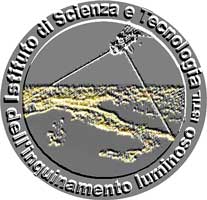Istituto di Scienza e Tecnologia dell'Inquinamento Luminoso
Light Pollution Science and Technology Institute
The night sky in the WorldSatellite monitoring of the artificial night sky brightness and the stellar visibility |
The DMSP satellite and its Operational Linescan System
U.S. Air Force Defense Meteorological Satellite Program (DMSP) satellites are in low altitude (830 km) sun-synchronous polar orbits with an orbital period of 101 minutes. With 14 orbits per day they generate a global night time and day time coverage of the Earth every 24 hours with their main purpose to monitor the distribution of clouds and to assess navigation conditions.
The U.S. Department of Commerce, NOAA National Geophysical Data Center (NGDC) serves as the archive for the DMSP program. The digital archive was initiated in 1992. Starting in 1994, NGDC has embarked on the development of night time lights processing algorithms and products from the DMSP-OLS.
The Operational Linescan System (OLS) is an oscillating scan radiometer with low-light visible and thermal infrared (TIR) imaging capabilities which first flew on DMSP satellites in 1976.
At night the OLS uses a Photo Multiplier Tube (PMT) to intensify the visible band signal. The purpose of this intensification is to observe clouds illuminated by moonlight.
The PMT data have a broad spectral response from 440 to 940 nm (485 - 765 nm FWHM) with highest sensitivity in the 500 to 650 nm region. This covers the range for primary emissions from the most widely used lamps for external lighting: Mercury Vapour (545 nm and 575 nm), High Pressure Sodium (from 540 nm to 630 nm), Low Pressure Sodium (589
nm).
The OLS acquires swaths of data that are 3000 km wide. The OLS sinusoidal scan maintains a nearly constant along-track pixel-to-pixel ground sample distance (GSD) of 0.56 km. Likewise, the electronic sampling of the signal from the individual scan lines maintains a GSD of 0.56 km. The effective instantaneous field of view (EIFOV) is larger than the 0.56 km GSD and varies with scan angle. At nadir the EIFOV is 2.2 km and expands to 5.4 km at the edge of scan 1500 km out from nadir. Most of the data received by NGDC has been "smoothed" by on-board averaging of 5
x 5 pixel blocks, yielding data with a GSD of 2.8 km.
DMSP platforms are stabilized using four gyroscopes (three axis stabilization), and platform orientation is adjusted using a star mapper, an Earth limb sensor, and a solar detector (Elvidge et
al. 1997a). Daily radar bevel vector sightings of the satellites provided by Naval Space Command allow Air Force orbital mechanics models to compute geodetic subtrack of each orbit giving the position of satellites every 0.4208 seconds. This position together with OLS scan angle equations, an oblate ellipsoid Earth sea level model and digital terrain elevations from U.S. Geological Survey, EROS Data center, allow geolocation algorithms to estimate latitude and longitude for each pixel center.
Normally the OLS is operated at high gain settings for cloud detection. City lights are saturated in these data and radiances can not be
extracted. Under special requests to the Air Force NGDC was able to
collect OLS PMT data at reduced gain settings. During these experimental data collections on board algorithms which adjust the visible band gain
are disabled. The major on-board algorithm which effects the night time visible band data is the along scan gain control (ASGC), which adjust the gain dynamically in response to scene brightness. There is also a on-board bi-directional reflectance (BRDF) algorithm designed to reduce the brightness of the image "hot-spot" which occurs where the observation angles matches the illumination angle. The BRDF algorithm has minimal effect when lunar illumination is low, as was the case during the 28 nights in which the gain controlled data were acquired. The two on-board gain control algorithms were turned off to simplify the retrieval of radiances from the special data collections.
During the special data acquisition the OLS VDGA gain, which is normally operated at 60 dB,
is reduced to avoid saturation in urban centres. On one set of nights the gain
is operated at lower setting in order to avoided saturation on major on major urban centres, but
this do not permit detection of city edges and lighting in smaller towns. To overcome this dynamic range limitation, data
are also acquired at higher gain settings.
